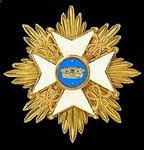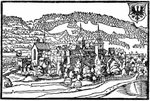First raised 1679. Chef in 1756 was Major General Georg Friedrich von Amstell, who was killed in action at Prague on the 6th May 1757. His successor from the 12th December that year was Major General Karl Ferdinand, Baron von Hagen, called Geist, who died on the 19th February 1759 of wounds received at Hochkirch. From 25th February 1759 his replacement was Major General Julius Dietrich von Queiss, who lasted to 1769.
I have been working on an improved, more authentic and more detailed eagle; the one used here is after Bleckwenn's illustrations. In future I shall probably offer two versions of the flags, one with the new eagle but also one with the old, in order to maintain consistency for those who have already printed versions of my previous flags. Eventually I would like to update the older Prussian flags with the new improved eagle but will still offer the old version for those who might prefer it.
At the beginning of the Seven Years War the regiment was kept in reserve as an elite Pomeranian regiment but then sent to Lusatia in December 1756, serving under the Duke of Bevern at the battle of Reichenberg on April 21st 1757. Having joined Schwerin's army the regiment fought at Prague. After Kolin the grenadiers were captured after defending the town of Gabel but released the following spring. Having experienced defeat at the battle of Breslau on 2nd November, the regiment was at Leuthen on 2nd December with the King's army, suffering around 30% casualties, according to Duffy Army of Frederick the Great 1st Edition. With the King's army again in 1758, the grenadiers suffered heavy casualties at Domstadtl on June 30th. At Zorndorf on 25th August they suffered 193 casualties. Both grenadiers and the rest of the regiment were with the King at Hochkirch on October 14th. When the large battery of 20 12-pounders and 6 field guns at the the south-east corner of the village was lost to the attacking Austrians, Major General von Geist wished to retake it. He was mortally wounded attempting to do so and died on February 19th 1759 from his wounds. The Austrians turned the Prussian guns against their former owners and defeated all attacks with blasts of grapeshot; the First Battalion of IR8 was able only to defend the western edge of the village and its gardens. Losses were around 50% of the two battalions (Duffy). The grenadiers fought on the left wing, facing the Austrians' second attack. They lost nearly 50% in casualties (Duffy).
In 1759 the regiment went with the King's army to the camp at Schmottseiffen to secure Silesia from the south and north. In 1760 IR8 joined Prince Henry's corps, which joined up with the King on August 29th after Liegnitz, in which the grenadiers took part on the part of the field away from Loudon's attack. At Torgau on 3rd November 1760 IR8 was part of the second attack after the failure of the advance guard, and advanced to the Süptitz Heights where it held off all counterattacks but suffered huge casualties. Dorn and Engelmann say that the regiment lost 1000 out of 1300.
Christopher Duffy says that in 1784 Frederick said that the troops of IR8 looked "like a mob of ignorant peasants"!
And this is the musketeer uniform in 1756:






















